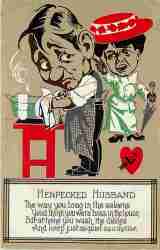Having undertaken research on power relations in heterosexual relationships I have realized how complicated these gendered power balances are. When you listen to contemporary discussions about masculinity being in crisis as a result of gender equality going wild, it seems that dominated men are the product of the last 40 years of feminist power gain. However, a little historical digging has revealed that the figure of the henpecked husband is both old and cross-culturally recognized. For centuries, the henpecked husband has worked as a masculine demarcation and ridiculed compliance as a sign of male weakness.
The Danish term in itself is kind of funny. We talk about slipper heroes. When I looked the term up in a dictionary, it revealed a long history as the expression ‘being under the slipper’ can be found in classic Danish literature as far back as the middle of the 18th century. In classic comedies, you find bossy wives hitting their husbands with their shoes to the vast amusement of the audience. Etymologically, the notion originates from German where it probably derives from an old wedding ritual where the bride and the groom played a game of stepping on each other’s feet. The person who ended on top was said to be the one holding the power in the relation.
Likewise, shoes are also said to have played a symbolic part in ancient Egyptian wedding ritual. The father of the bride would take her shoes and present them to the groom as a symbol of the power over her passing from the father to her husband. The groom would accept this right by hitting her on the head with her shoes manifesting that he was the one in charge. Shoes have had a symbolic power of signaling power and domination for a long time.
But what about the slipper hero? Already in ancient Greece, we find a story of the famous philosopher Socrates complying with his dominant wife Xanthippe. In Xenofon’s classic book Symposium, we hear about Socrates’ wife as dominant and shrewish. Socrates argues that he actually likes this challenge, but is also portrayed as someone who is putting up with a lot of trouble. Perhaps it’s a challenge, perhaps he does it out of love, or maybe because it is just easier to let her run the show instead of demonstrating his authority as a man. No matter the reason, what happens is that Socrates complies and therefore he is ridiculed. What man would willingly accept such disrespect from a woman? His compliance is captured in this classic painting of her pouring water on him.

Xanthippe and Socrates Source: http://en.wikipedia.org/wiki/Xanthippe
In medieval Europe we find another story, which informs us about the pleasantry of male compliance. Phyllis was the beautiful wife or concubine of Alexander the Great. The young emperor’s adviser, who over the years turned into the philosopher Aristotle, was dissatisfied with the emperor spending more time on his mistress than on fighting wars, so he told the emperor to break up with Phyllis. As revenge, Phyllis seduced the philosopher and with woman’s wiles she persuaded him to let her ride on his back. She arranged for the emperor to see this proving that the wise master himself was also weak.

Phyllis on the back of Aristotle Source: http://commons.wikimedia.org/wiki/File:Aristotle_and_Phyllis.jpg
The moral of the story is said to be that the women’s power of physical seduction is stronger than man’s reason. The picture of Phyllis on the back of the great philosopher became one of the most popular motifs in the Renaissance. This indicates that men’s compliance was already then a piquant subject, and that stories of male weakness were constructed as amusing.
The henpecked husband stayed a subject of humor and amusement through the centuries. With the prevalence of the printing press, he became the subject of postcards and valentines cards. The first card below is a so-called ‘one penny print’ from the middle of the 18th century when multi-color print had just become possible. It shows a man getting spanked by his wife while the text says something about her hearing the baby cry while she spanks him.

‘One penny print’
Source: http://www.prepressure.com/printing/history/1800-1899
That it is supposed to be funny seems odd today, where domestic violence is ill regarded. However, in times where a woman was the property of her husband and his ‘natural’ right to inflict corporal punishment untouched, this play with flipping roles would have probably been hilarious. The tradition was also exported to the United States as we can see on this vintage American valentine card from the early 20th century.

American Valentines card, New York early 20th century.
Source: http://www.ebay.com/itm/Valentine-Vinegar-Henpecked-Husband-Washes-Dishes-Wife-Lectures-Vintage-Postcard-/220902239753
It is kind of hard to imagine this mocking card being given as a romantic devotion of love. Cards like this are made for the sake of teasing men who complied with their wives. Imagine a man who would do the dishes voluntarily. Or maybe even think it was his responsibility too. Ha ha!
So, what can we learn from the historical prevalence of the henpecked husband? He might be pitied, but most importantly his suppression has been the object of ridicule. Why is this? For almost two centuries, feminist women and men have been fighting a serious battle for women’s freedom from repression. Why has no one fought for the henpecked husbands? Maybe because no one really sees him as dominated. His submission is seen as compliance. And compliance passes as an internal weakness in the man, not as something imposed on him by an outside force. By choosing to give in, the henpecked husband dismisses the basic rules of displaying manhood, that is, to perform strength, willfulness and to take up the amount of space that a man needs and is entitled to. The henpecked husband is not a product of the feminist movement nor of social progress. He is the scapegoat of male fear of the loss of autonomy and of showing compassion and caring about others; emotions that are labeled as weakness in male bodies. This fear still plays a significant part in the construction of masculinity in contemporary societies. To be caring and to comply is not necessarily the same thing, but the line between the two is so thin, that I guess more than one man has failed to show carefulness and consideration in order not to be emasculated and labelled ‘henpecked’.
Bio:
Anna Sofie is a visiting scholar at The Center for the Studies of Men and Masculinities in the spring 2014. She is a PhD candidate at Department of Sociology at the University of Copenhagen, Denmark. Anna Sofie’s current research interest is how social change affects the gendered structures of intimate life. Her current research focuses on men’s experiences of living with a woman who has a career job.

Interesting article. I suppose the question for me is whether feminism has changed the cultural and mental landscape or not. The hen-pecking wife image is evident in the old patriarchal culture in Spain, where I live. The woman dominates the house, where the man is barely tolerated, and the man dominates the outside world where he always drives the car, for example. I think it is possible to live more compassionate and vital lives than this old stereotype, but am rather pessimistic about the world as a whole. Young men are attracted to “bro” culture- a lame warrior ethic- and young women look on with a half scornful attraction: it seems like the same structure to me. Sad.
Loved this article! I have been studying men’s health and masculinity for several years, and this article gave me an important perspective which has helped to articulate much of what I believe is going on with men’s resistance to health initiatives. Besides ‘health’ being a feminised space, hegemonic masculinity involves a non-compliance imperative to avoid not only performing behaviours associated with ‘what women do’, but to avoid becoming the equivalent of the hen-pecked husband: the man who acquiesces to ‘do-gooder’ exhortations to behave in ways consistent with ‘good health’.
As a husband if I reveal my sexual tastes I am classed as a submissive, but it is not so straightforward as that. I am certainly not henpecked and I do make a boundary if I feel I am controlled. My wife tries her best to be submissive to me so things are not that simple. We are complicated creatures.